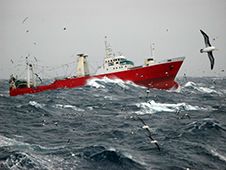
Wandering Albatrosses Diomedea exulans (Vulnerable) are at high risk from bycatch because their large foraging ranges expose them to multiple fisheries across national and international waters. In a recent project led by BirdLife, data from loggers that record positions of birds and detect radar transmissions from nearby fishing vessels were integrated with the locations of individual vessels to identify areas, gear types and flag states (fishing nations) representing the greatest bycatch risk. For Wandering Albatrosses, this shows that they are at the highest risk of interacting with fishing vessels during their incubation and chick-rearing periods. Out of 251 tagged birds, 43% showed close attendance at fishing vessels, with the greatest overlap occurring with demersal longline vessels flagged to South Korea.
Albatross populations at South Georgia in the southern Atlantic Ocean have been in decline since the 1970s, with an estimated 40-60% decrease across three species (Wandering Albatross Diomedea exulans, Vulnerable; Grey-headed Albatross Thalassarche chrysostoma, Endangered; and Black-browed Albatross Thalassarche melanophris) in the last 35 years (Pardo et al. 2017). Bycatch has been identified as the primary threat, with Wandering Albatrosses particularly at risk because their large foraging ranges expose them to multiple fisheries across national and international waters.
In a project led by BirdLife and funded by the Darwin Plus scheme, data from loggers that record GPS positions of birds and detect radar transmissions from nearby fishing vessels were integrated with the locations of individual vessels derived from their Automatic Identification System to analyse fine-scale overlap between Wandering Albatrosses and fishing vessels (Carneiro et al. 2022). This allowed the identification of areas, gear types and flag states (fishing nations) representing the greatest bycatch risk at different life stages. The results showed that Wandering Albatrosses are at the highest risk of interacting with fishing vessels during their incubation and chick-rearing periods when birds travel to the Patagonian Shelf Break. Out of 251 tagged birds, 55% encountered fishing vessels (i.e. were within 30 km), and 43% showed close attendance at fishing vessels (i.e. within 5 km). The greatest overlap was with demersal longline vessels, particularly from South Korea but also from the United Kingdom and Chile, and to a lesser extent, trawlers flagged to Argentina and Uruguay, and pelagic longline vessels flagged to Brazil, Portugal and Taiwan, China.
Related Species
References
Carneiro, A. P. B., Clark, B. L., Pearmain, E. J., Clavelle, T., Wood, A. G. & Phillips, R. A. (2022) Fine-scale associations between wandering albatrosses and fisheries in the southwest Atlantic Ocean. Biol. Conserv. 276: 109796
Pardo, D., Forcada, J., Wood, A. G., Tuck, G. N., Ireland, L., Pradel, R., Croxall, J. P. & Phillips, R. A. (2017) Additive effects of climate and fisheries drive ongoing declines in multiple albatross species. PNAS 114(50): E10829-E10837
Compiled: 2022 Last updated: 2022
Recommended Citation:
BirdLife International (2022)
Fishing vessels pose a high risk to South Georgia’s Wandering Albatrosses.
Downloaded from https://datazone.birdlife.org/sowb/casestudy/fishing-vessels-pose-a-high-risk-to-south-georgias-wandering-albatrosses on 22/12/2024